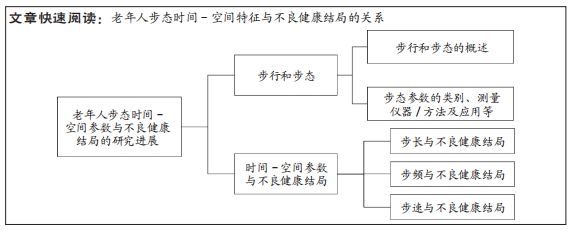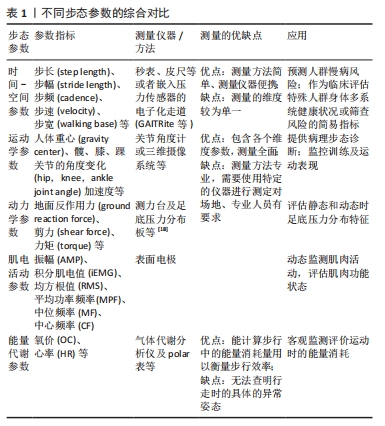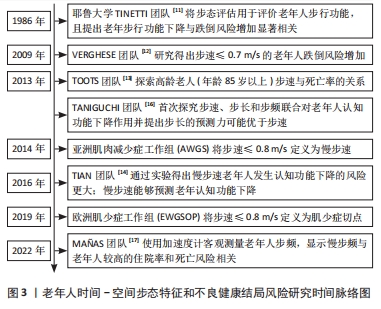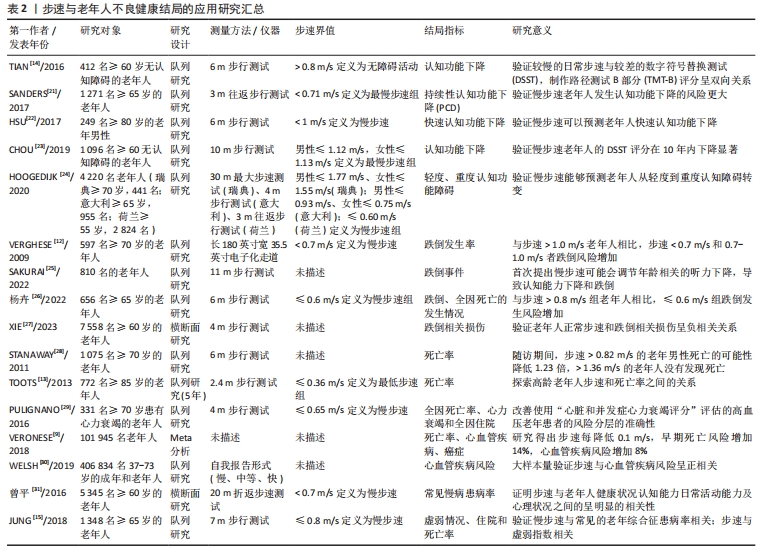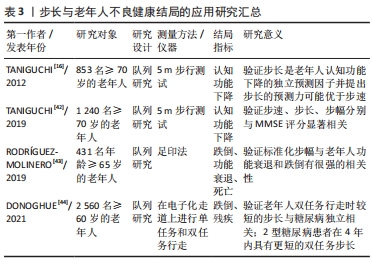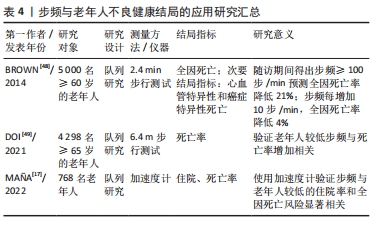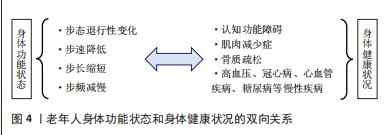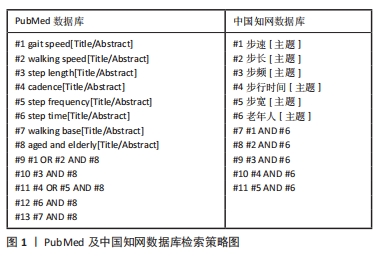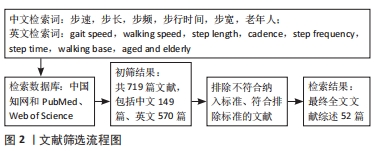[1] 蔡敏,谢学勤,吴士勇.我国老年人口健康状况及卫生服务利用[J].中国卫生信息管理杂志,2021,18(1):27-34,49.
[2] 刘敏,李玉茹,王健,等.不同步速条件下超重肥胖老年人步态运动学特征[J].中国老年学杂志,2022,42(13):3216-3220.
[3] MIDDLETON A, FRITZ SL, LUSARDI M. Walking speed: the functional vital sign. J Aging Phys Act. 2015;23(2):314-322.
[4] WALSH JA, BARKER RE, KON SSC, et al. Gait speed and adverse outcomes following hospitalised exacerbation of COPD. Eur Respir J. 2021;58(5): 2004047.
[5] 王莉,于卫华.步态分析在老年人跌倒中的应用进展[J].中华护理杂志, 2016,51(3):347-351.
[6] 张杰,沈通桃.步速在老年患者评估中的应用[J].国际麻醉学与复苏杂志,2020,41(12):1191-1195.
[7] 吴梦余,于卫华.步行速度在老年衰弱相关不良事件中的应用进展[J].护理学报,2018,25(17):21-24.
[8] 路菲,王青,杨卉.老年人步速和握力与不良健康结局关系的研究进展[J].中华老年医学杂志,2021,40(11):1444-1448.
[9] VERONESE N, STUBBS B, VOLPATO S, et al. Association between gait speed with mortality, cardiovascular disease and cancer: a systematic review and meta-analysis of prospective cohort studies. J Am Med Dir Assoc. 2018;19(11):981-988.e7.
[10] SNIJDERS AH, VAN DE WARRENBURG BP, GILADI N, et al. Neurological gait disorders in elderly people: clinical approach and classification. Lancet Neurol. 2007;6(1):63-74.
[11] TINETTI ME. Performance-oriented assessment of mobility problems in elderly patients. J Am Geriatrs Soc. 1986;34(2):119-126.
[12] VERGHESE J, HOLTZER R, LIPTON RB, et al. Quantitative gait markers and incident fall risk in older adults. Journals Gerontol A Biol Sci Med Sci. 2009;64A(8):896-901.
[13] TOOTS A, ROSENDAHL E, LUNDIN-OLSSON L, et al. Usual gait speed independently predicts mortality in very old people: a population-based study. J American Med Dir Assoc. 2013;14(7):529.e1-529.e6.
[14] TIAN Q, AN Y, RESNICK S M, et al. The relative temporal sequence of decline in mobility and cognition among initially unimpaired older adults: results from the baltimore longitudinal study of aging. Age Ageing. 2016;46(3): 445-451.
[15] JUNG HW, JANG IY, LEE CK, et al. Usual gait speed is associated with frailty status, institutionalization, and mortality in community-dwelling rural older adults: a longitudinal analysis of the aging study of pyeongchang rural area. Clin Interv Aging. 2018;13:1079-1089.
[16] TANIGUCHI Y, YOSHIDA H, FUJIWARA Y, et al. A prospective study of gait performance and subsequent cognitive decline in a general population of older Japanese. J Gerontol A Bio Sci Med Sci. 2012;67(7):796-803.
[17] MAÑAS A, DEL POZO CRUZ B, EKELUND U, et al. Association of accelerometer-derived step volume and intensity with hospitalizations and mortality in older adults: a prospective cohort study. J Sport Health Sci. 2022;11(5):578-585.
[18] 钱竞光,宋雅伟,叶强,等.步行动作的生物力学原理及其步态分析[J].南京体育学院学报(自然科学版),2006,5(4):1-7, 39.
[19] 崔玉鹏,洪峰.表面肌电图在人体运动研究中的应用[J].首都体育学院学报,2005,17(1):102-104, 114.
[20] 王桂茂,严隽陶.应用三维运动解析技术定量观测步态变化[J].中国组织工程研究与临床康复,2007,11(35):7081-7083.
[21] SANDERS JB, BREMMER MA, COMIJS HC, et al. Gait speed and processing speed as clinical markers for geriatric health outcomes. Am J Geriatr Psychiatry. 2017;25(4):374-385.
[22] HSU CL, LIANG CK, LIAO MC, et al. Slow gait speed as a predictor of 1-year cognitive decline in a veterans’ retirement community in southern Taiwan: The relationship between low gait speed and one-year cognitive decline. Geriatr Gerontol Int. 2017;17 Suppl 1:14-19.
[23] CHOU MY, NISHITAY, NAKAGAWA T, et al. Role of gait speed and grip strength in predicting 10-year cognitive decline among community-dwelling older people. BMC Geriatr. 2019;19(1):186.
[24] HOOGENDIJK EO, RIJNHART JJM, SKOOG J, et al. Gait speed as predictor of transition into cognitive impairment: findings from three longitudinal studies on aging. Exp Gerontol. 2020;129:110783.
[25] SAKURAI R, KAWAI H, YANAI S, et al. Gait and age‐related hearing loss interactions on global cognition and falls. Laryngoscope. 2022;132(4): 857-863.
[26] 杨卉,崔云婧,张少景,等.步速和握力对住院老年患者全因死亡和跌倒的预测价值研究[J].中国全科医学,2022,25(32):4010-4017.
[27] XIE H, CHEN E, ZHANG Y. Association of walking pace and fall-related injury among Chinese older adults: data from the SAGE survey. Complementary The Clin Pract. 2023;50:101710.
[28] STANAWAY FF, GNJIDIC D, BLYTH FM, et al. How fast does the Grim Reaper walk? Receiver operating characteristics curve analysis in healthy men aged 70 and over. BMJ. 2011;343:d7679.
[29] PULIGNANO G, DEL SINDACO D, DI LENARDA A, et al. Incremental value of gait speed in predicting prognosis of older adults with heart failure: insights from the IMAGE-HF study. JACC Heart Fail. 2016;4(4):289-298.
[30] WELSH CE, CELIS-MORALES CA, HO FK, et al. Grip strength and walking pace and cardiovascular disease risk prediction in 406,834 UK biobank participants. Mayo Clin Proc. 2020;95(5):879-888.
[31] 曾平,韩怡文,庞婧,等.步速降低与老年人健康及相关状况的关系[J].中华老年医学杂志,2016,35(7):773-777.
[32] LO AX, DONNELLY JP, MCGWIN G, et al. Impact of gait speed and instrumental activities of daily living on all-cause mortality in adults ≥65 years with heart failure. Am J Cardiol. 2015;115(6):797-801.
[33] ODDEN MC, PERALTA CA, HAAN MN, et al. Rethinking the association of high blood pressure with mortality in elderly adults: the impact of frailty. Arch Intern Med. 2012;172(15):1162-1168.
[34] LAURETANI F, RUSSO CR, BANDINELLI S, et al. Age-associated changes in skeletal muscles and their effect on mobility: an operational diagnosis of sarcopenia. J Appl Physiol. 2003;95(5):1851-1860.
[35] CLEGG A, ROGERS L, YOUNG J. Diagnostic test accuracy of simple instruments for identifying frailty in community-dwelling older people: a systematic review. Age Ageing. 2015;44(1):148-152.
[36] 刘莉,叶鹏, GUTIÉRREZ-MISIS A,等.西班牙老年人群的步速与高血压死亡风险的关系[J].中华高血压杂志,2015,23(5):464.
[37] 赵芳,周兴龙,张振清,等.中老年人步态指标与衰老关系的研究[J].体育科学,1998,18(6):78-81.
[38] LIM YP, LIN YC, PANDY MG. Effects of step length and step frequency on lower-limb muscle function in human gait. J Biomech. 2017;57:1-7.
[39] BIERYLA KA, BUFFINTON C. Effects of age and step length on joint kinetics during stepping task. J Biomech. 2015;48(10):1679-1686.
[40] CHO BL, SCARPACE D, ALEXANDER NB. Tests of stepping as indicators of mobility, balance, and fall risk in balance-impaired older adults. J Am Geriatr Soc. 2004;52(7):1168-1173.
[41] NNODIM JO, STRASBURG D, NABOZNY M, et al. Dynamic balance and stepping versus tai chi training to improve balance and stepping in at-risk older adults. J Am Geriatr Soc. 2006;54(12):1825-1831.
[42] TANIGUCHI Y, WATANABE Y, OSUKA Y, et al. Characteristics for gait parameters of community-dwelling elderly Japanese with lower cognitive function. PLoS One. 2019;14(3):e0212646.
[43] RODRÍGUEZ-MOLINERO A, HERRERO-LARREA A, MIÑARRO A, et al. The spatial parameters of gait and their association with falls, functional decline and death in older adults: a prospective study. Sci Rep. 2019;9(1):8813.
[44] DONOGHUE OA, LEAHY S, KENNY RA. Longitudinal associations between gait, falls, and disability in community-dwelling older adults with type II diabetes mellitus: findings from the irish longitudinal study on ageing (TILDA). J Gerontol A Bio Sci Med Sci. 2021;76(5):906-913.
[45] CAETANO MJD, MENANT JC, SCHOENE D, et al. Sensorimotor and cognitive predictors of impaired gait adaptability in older people. J Gerontol A Bio Sci Med Sci. 2017,72(9):1257-1263.
[46] 伍勰,陆爱云,庞军.健康老年人常速行走的步态分析[J].上海体育学院学报,2000,24(2):52-55, 64.
[47] SAINT-MAURICE PF, TROIANO RP, BASSETT DR, et al. Association of daily step count and step intensity with mortality among US adults. JAMA. 2020; 323(12):1151-1160.
[48] BROWN JC, HARHAY MO, HARHAY MN. Walking cadence and mortality among community-dwelling older adults. J Gen Intern Med. 2014;29(9): 1263-1269.
[49] DOI T, NAKAKUBO S, TSUTSUMIMOTO K, et al. Spatiotemporal gait characteristics and risk of mortality in community-dwelling older adults. Maturitas. 2021;151:31-35.
[50] DEL POZO CRUZ B, AHMADI MN, LEE IM, et al. Prospective associations of daily step counts and intensity with cancer and cardiovascular disease incidence and mortality and all-cause mortality. JAMA Intern Med. 2022; 182(11):1139-1148.
[51] DEL POZO CRUZ B, AHMADI M, NAISMITH SL, et al. Association of daily step count and intensity with incident dementia in 78 430 adults living in the UK. JAMA Neurol. 2022;79(10):1059-1063.
[52] CABRAL LP, FREIRE YA, BROWNE RAV, et al. Associations of steps per day and peak cadence with arterial stiffness in older adults. Exp Gerontol. 2022;157:111628. |
